Deep learning for epileptic spike detection
In the clinical diagnosis of epilepsy using electroencephalogram (EEG) data, an accurate automatic
epileptic spikes detection system is highly useful and meaningful in that the conventional manual process
is not only very tedious and time-consuming, but also subjective since it depends on the knowledge
and experience of the doctors. In this paper, motivated by significant advantages and lots of achieved
successes of deep learning in data mining, we apply Deep Belief Network (DBN), which is one of the
breakthrough models laid the foundation for deep learning, to detect epileptic spikes in EEG data. It is
really useful in practice because the promising quality evaluation of the spike detection system is higher
than 90%. In particular, to construct the accurate detection model for non-spikes and spikes, a new set
of detailed features of epileptic spikes is proposed that gives a good description of spikes. These features
were then fed to the DBN which is modified from a generative model into a discriminative model to aim
at classification accuracy. A performance comparison between using the DBN and other learning models
including DAE, ANN, kNN and SVM was provided via numerical study by simulation. Accordingly, the
sensitivity and specificity obtained by using the kind of deep learning model are higher than others. The
experiment results indicate that it is possible to use deep learning models for epileptic spike detection
with very high performance.
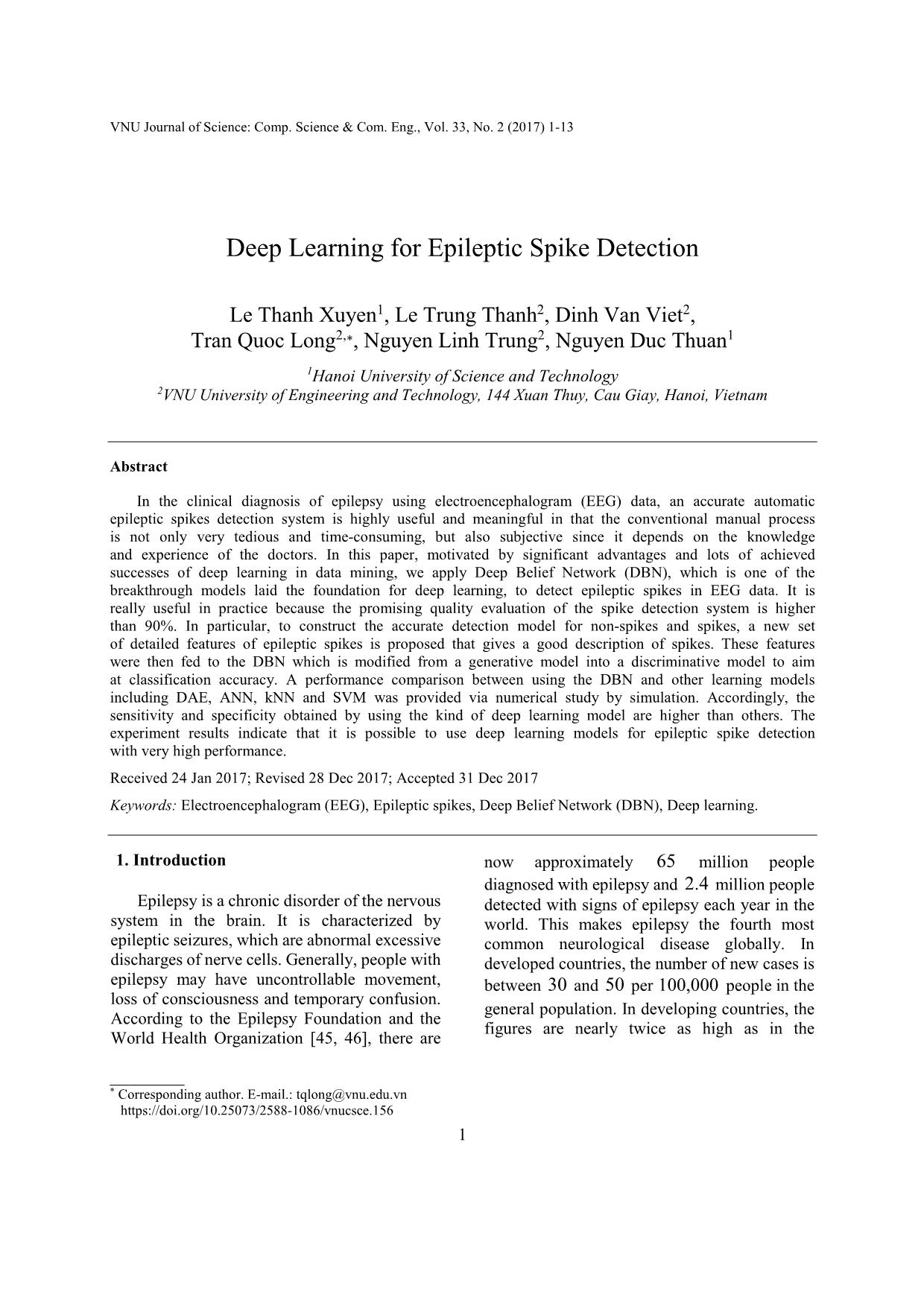
Trang 1
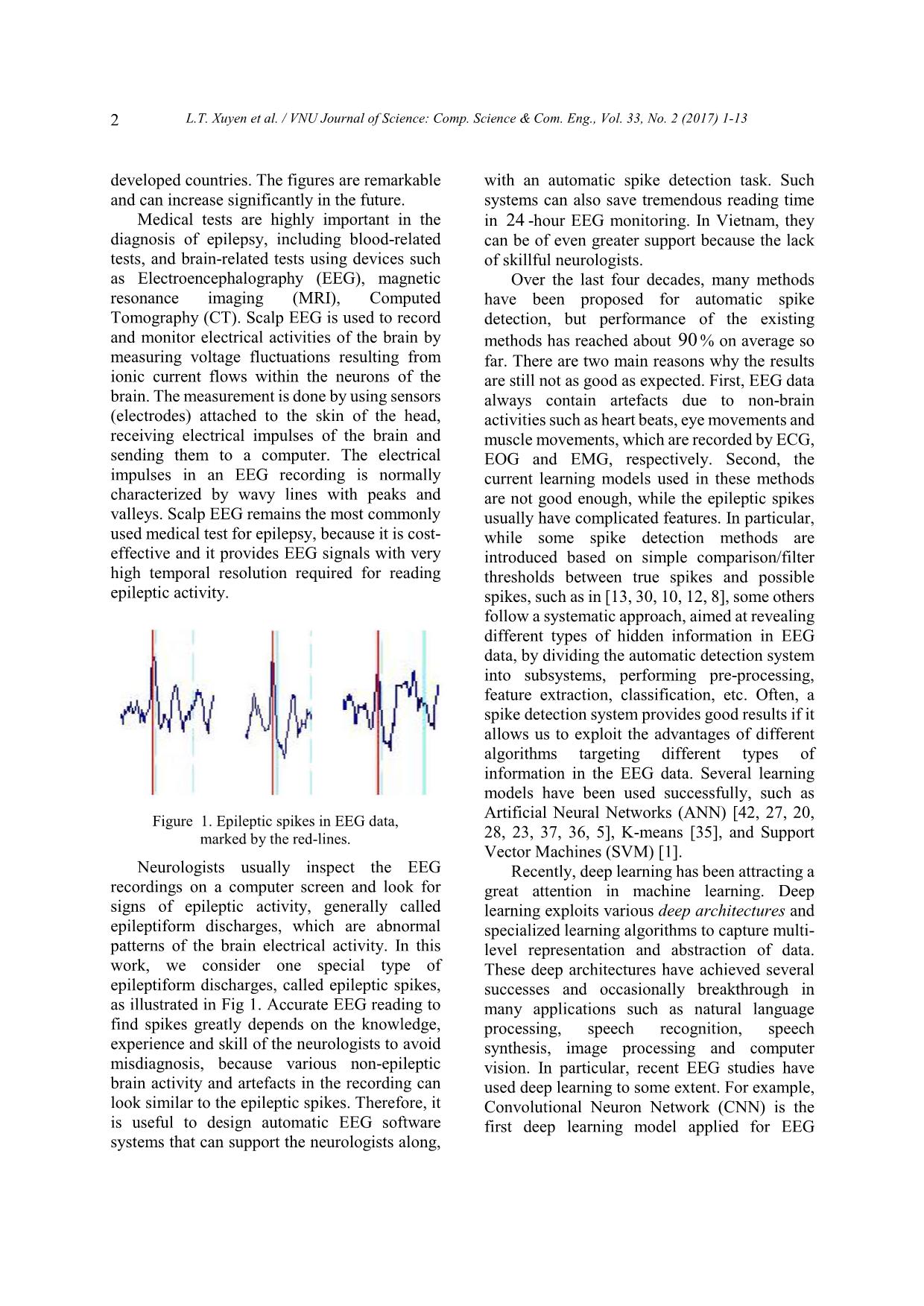
Trang 2
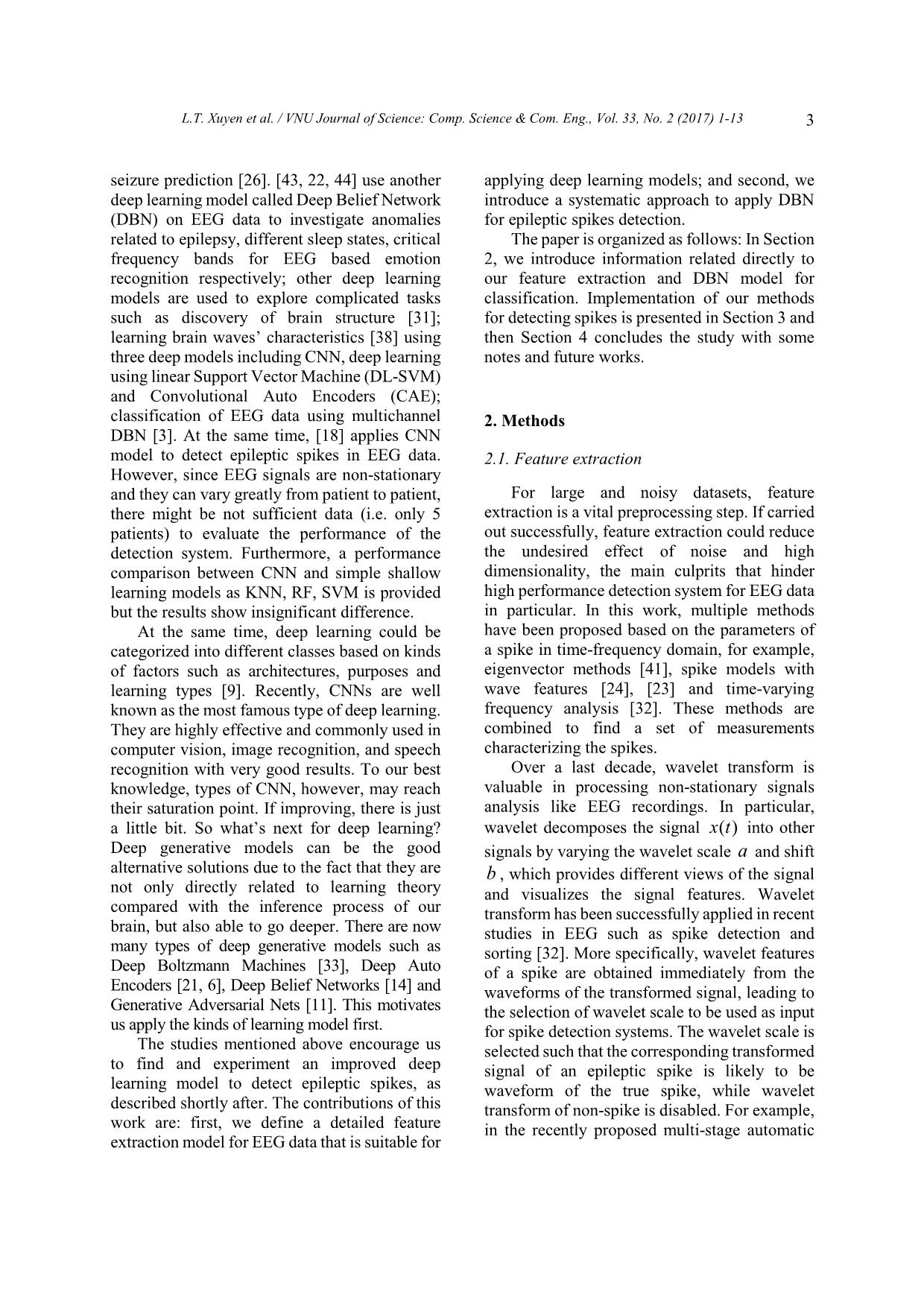
Trang 3
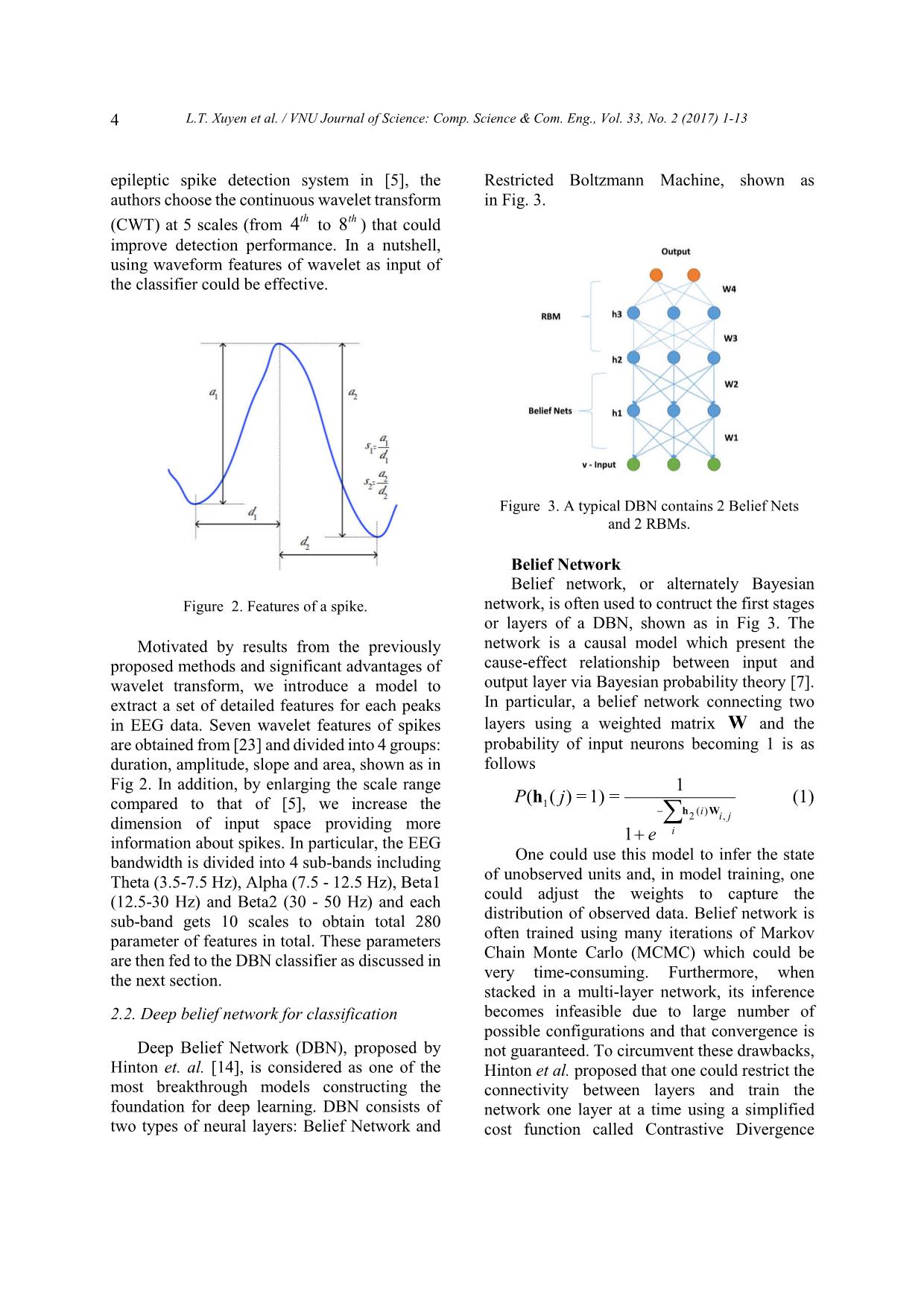
Trang 4
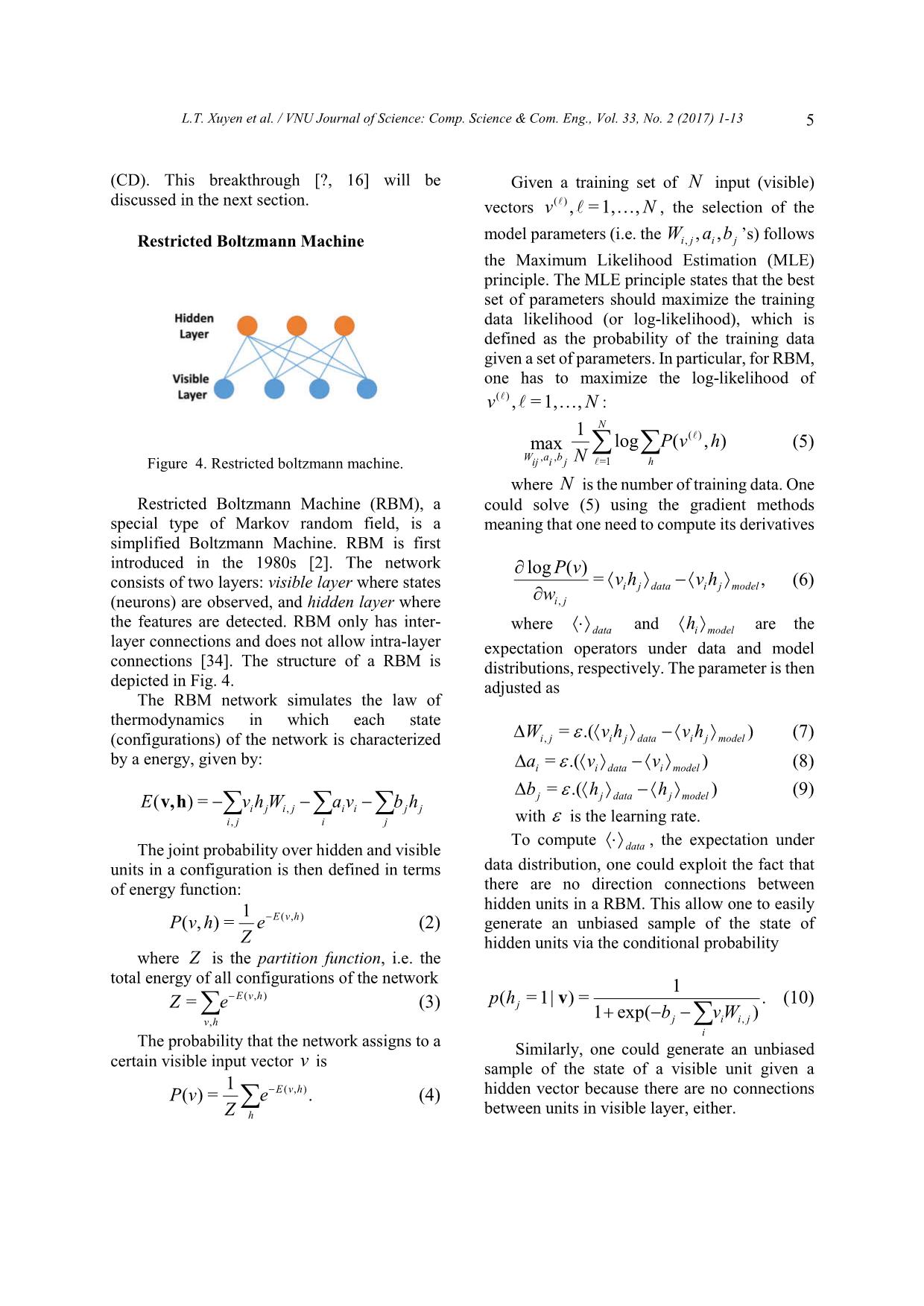
Trang 5
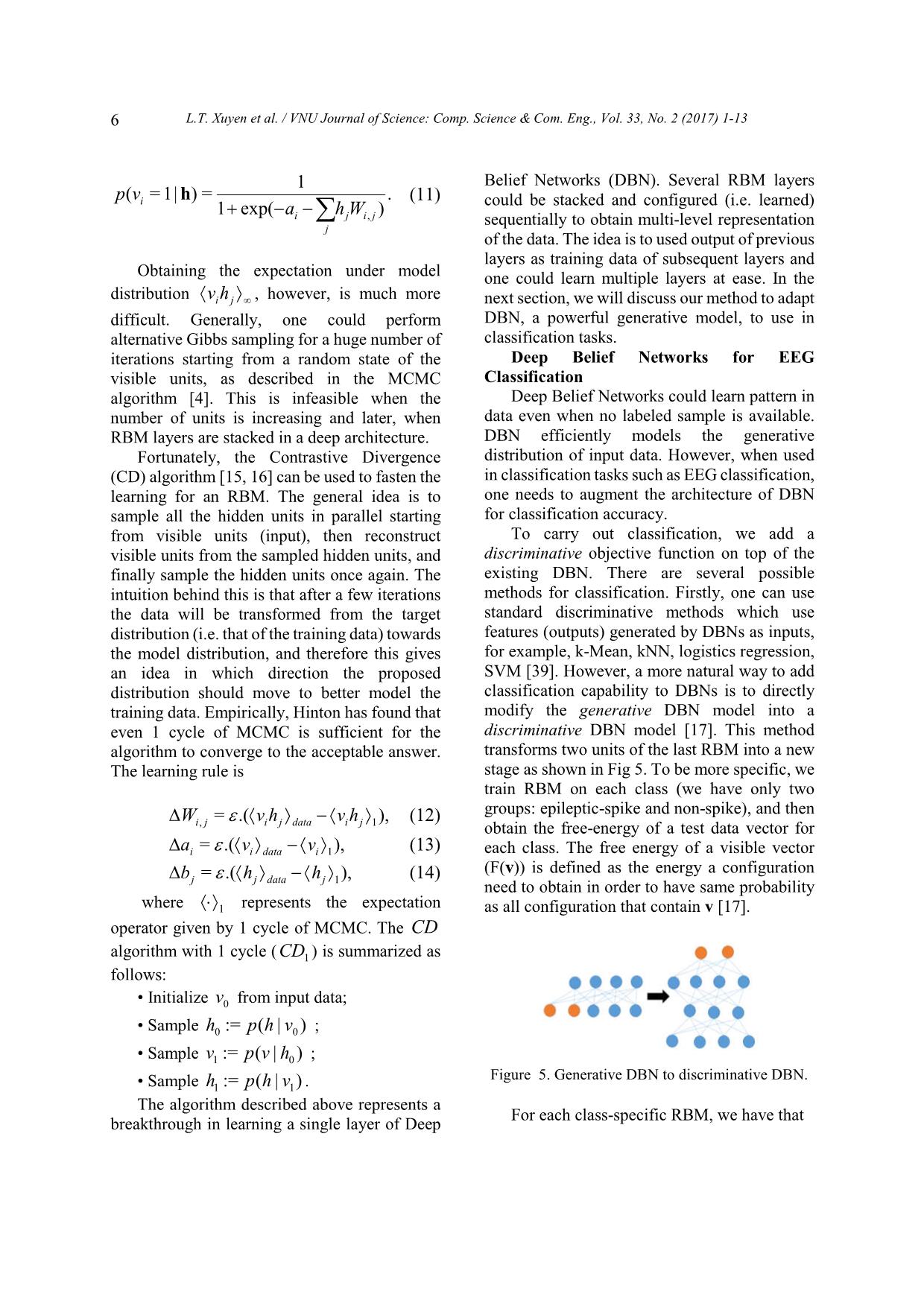
Trang 6
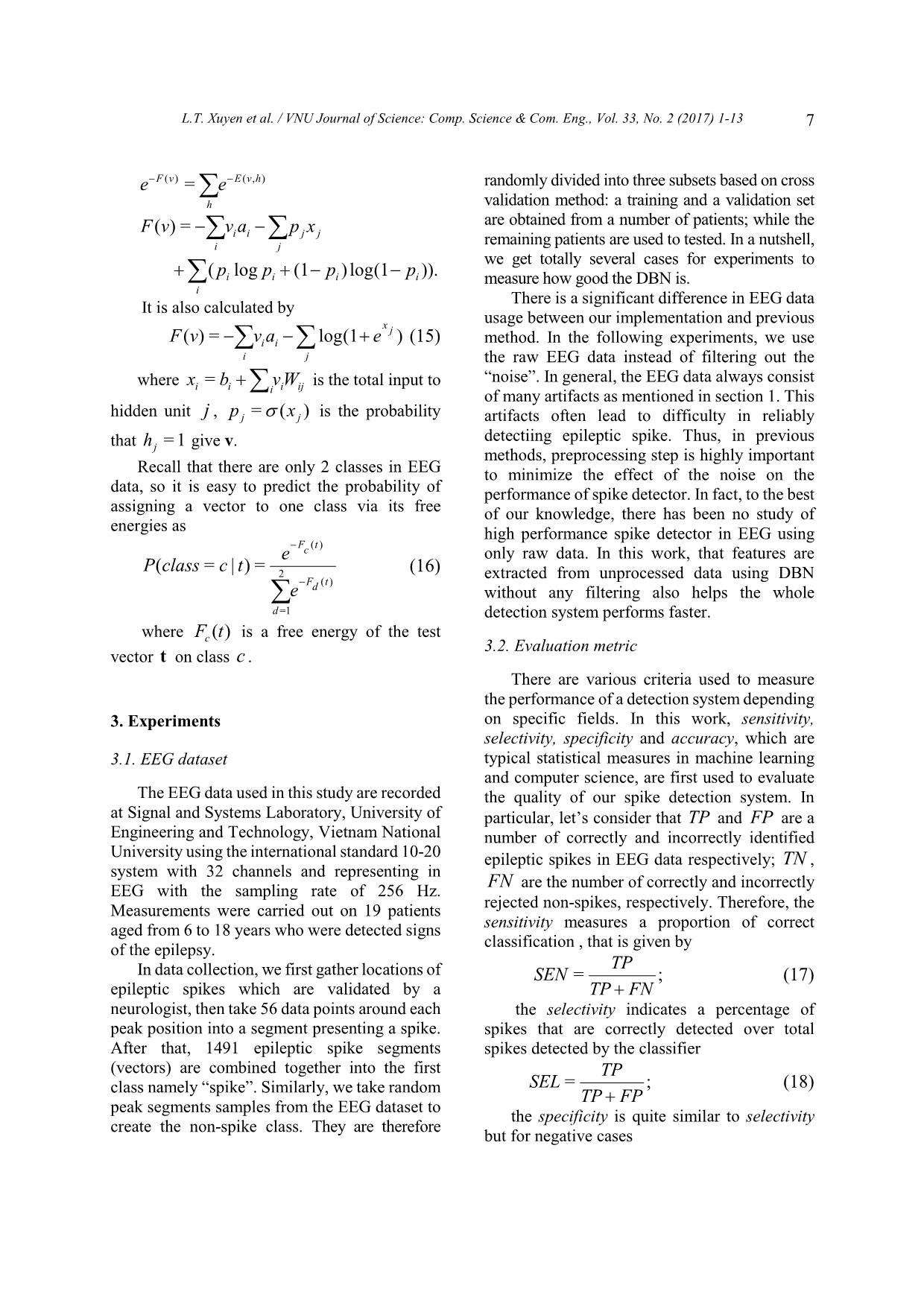
Trang 7
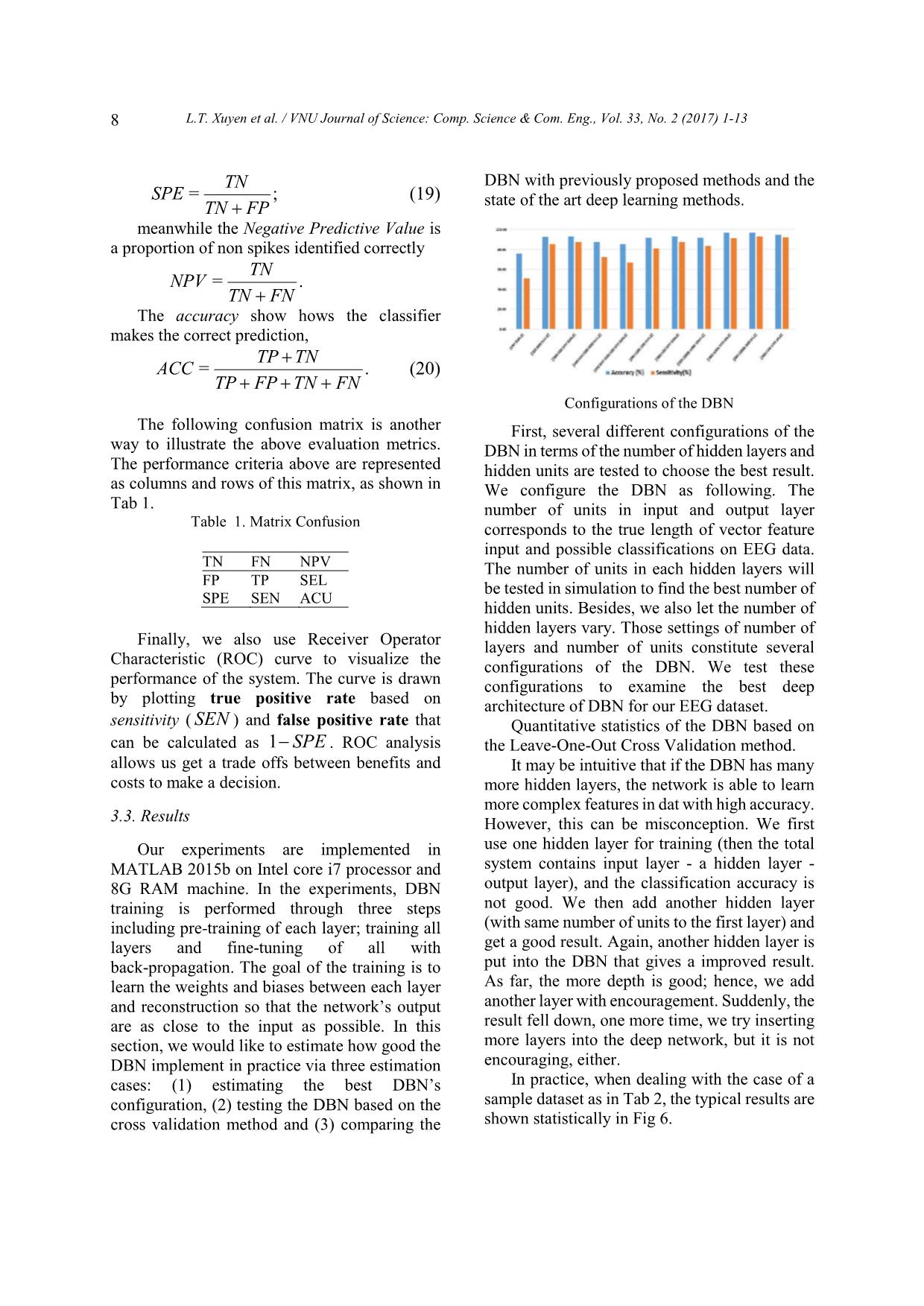
Trang 8
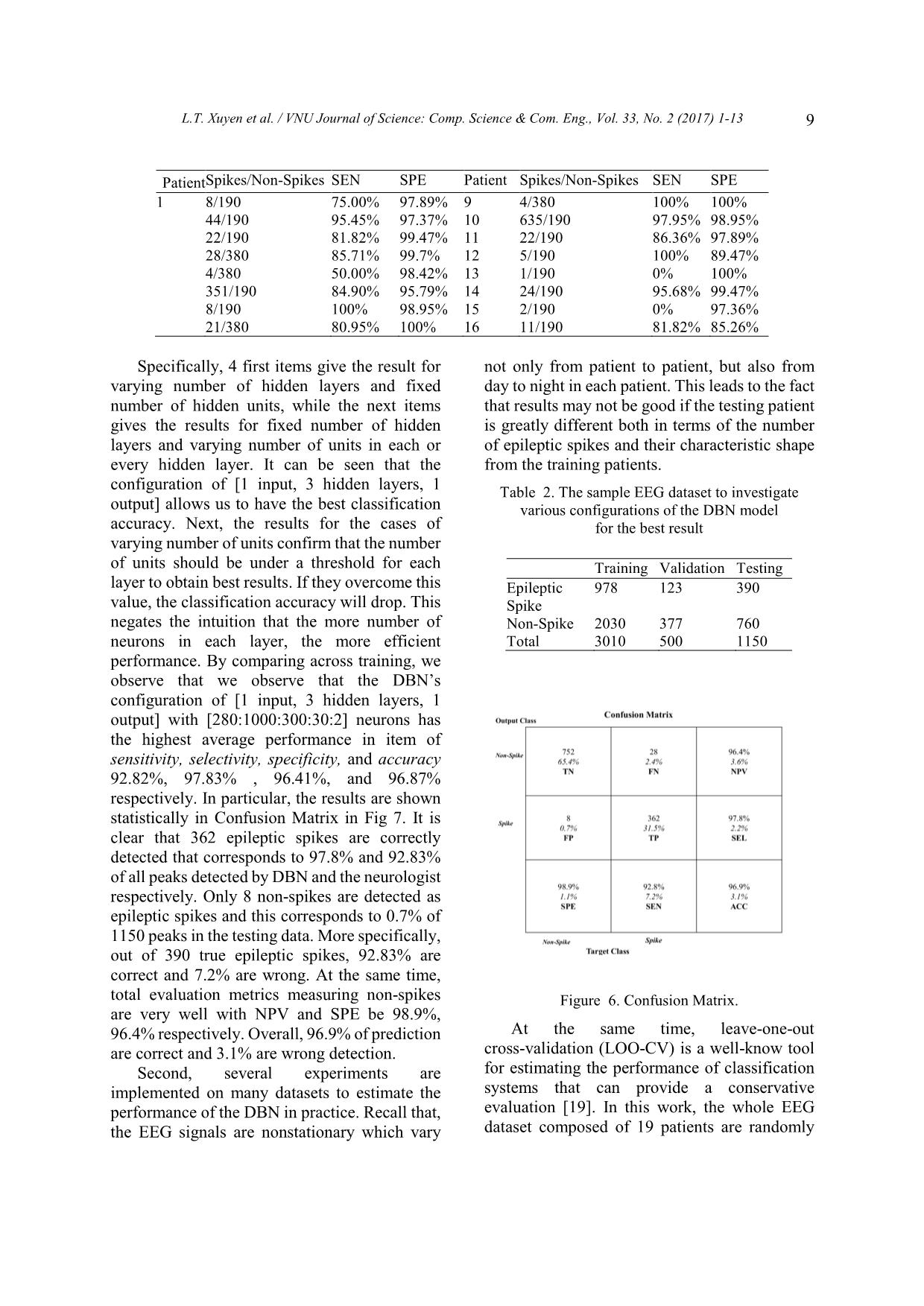
Trang 9
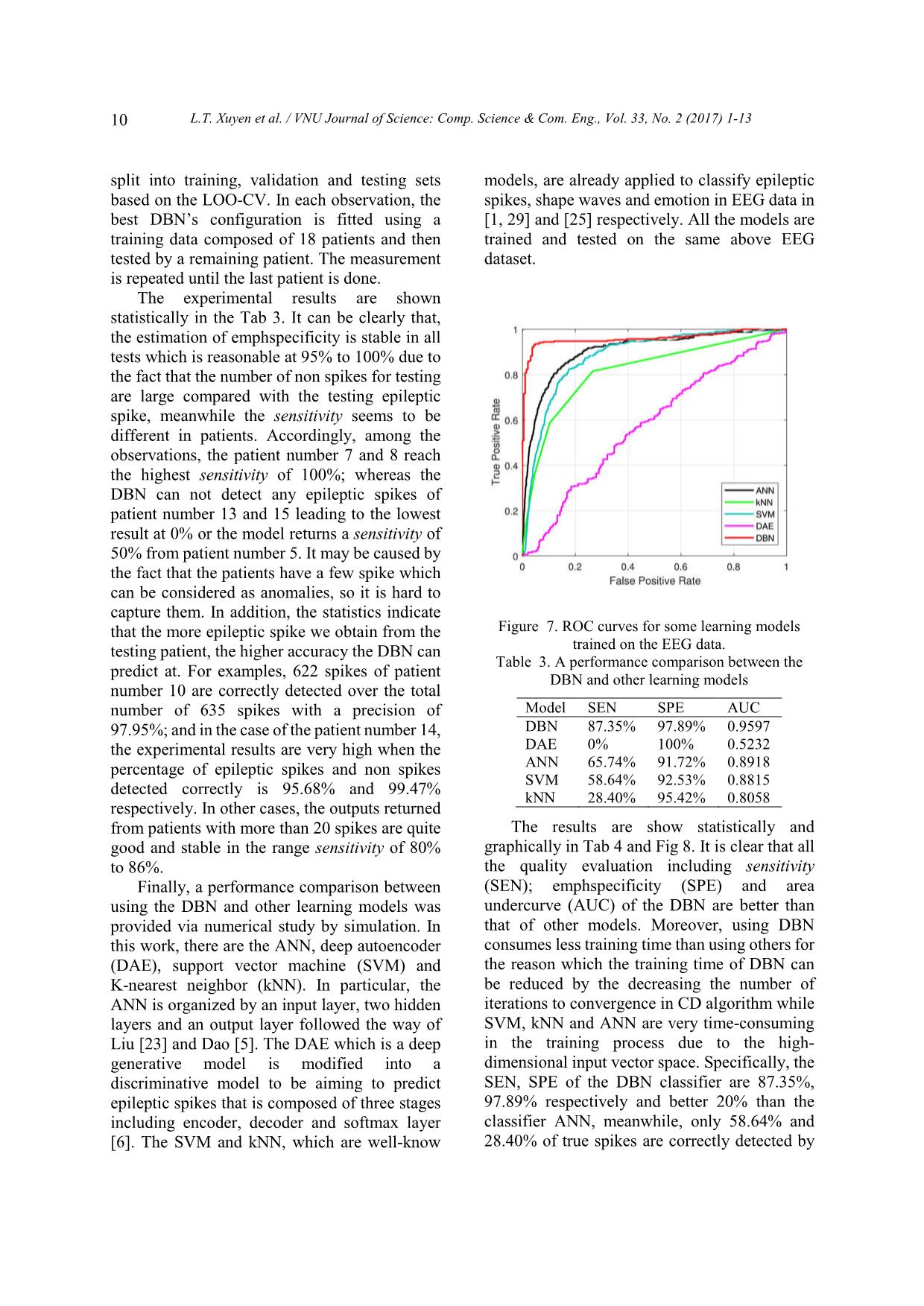
Trang 10
Tải về để xem bản đầy đủ
Tóm tắt nội dung tài liệu: Deep learning for epileptic spike detection
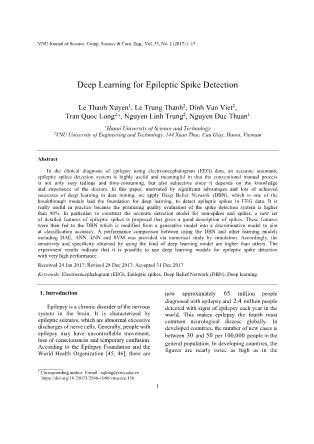
epileptic based on the LOO-CV. In each observation, the spikes, shape waves and emotion in EEG data in best DBN’s configuration is fitted using a [1, 29] and [25] respectively. All the models are training data composed of 18 patients and then trained and tested on the same above EEG tested by a remaining patient. The measurement dataset. is repeated until the last patient is done. The experimental results are shown statistically in the Tab 3. It can be clearly that, the estimation of emphspecificity is stable in all tests which is reasonable at 95% to 100% due to the fact that the number of non spikes for testing are large compared with the testing epileptic spike, meanwhile the sensitivity seems to be different in patients. Accordingly, among the observations, the patient number 7 and 8 reach the highest sensitivity of 100%; whereas the DBN can not detect any epileptic spikes of patient number 13 and 15 leading to the lowest result at 0% or the model returns a sensitivity of 50% from patient number 5. It may be caused by the fact that the patients have a few spike which can be considered as anomalies, so it is hard to capture them. In addition, the statistics indicate that the more epileptic spike we obtain from the Figure 7. ROC curves for some learning models testing patient, the higher accuracy the DBN can trained on the EEG data. Table 3. A performance comparison between the predict at. For examples, 622 spikes of patient DBN and other learning models number 10 are correctly detected over the total number of 635 spikes with a precision of Model SEN SPE AUC 97.95%; and in the case of the patient number 14, DBN 87.35% 97.89% 0.9597 the experimental results are very high when the DAE 0% 100% 0.5232 percentage of epileptic spikes and non spikes ANN 65.74% 91.72% 0.8918 SVM 58.64% 92.53% 0.8815 detected correctly is 95.68% and 99.47% kNN 28.40% 95.42% 0.8058 respectively. In other cases, the outputs returned from patients with more than 20 spikes are quite The results are show statistically and good and stable in the range sensitivity of 80% graphically in Tab 4 and Fig 8. It is clear that all to 86%. the quality evaluation including sensitivity Finally, a performance comparison between (SEN); emphspecificity (SPE) and area using the DBN and other learning models was undercurve (AUC) of the DBN are better than provided via numerical study by simulation. In that of other models. Moreover, using DBN this work, there are the ANN, deep autoencoder consumes less training time than using others for (DAE), support vector machine (SVM) and the reason which the training time of DBN can K-nearest neighbor (kNN). In particular, the be reduced by the decreasing the number of ANN is organized by an input layer, two hidden iterations to convergence in CD algorithm while layers and an output layer followed the way of SVM, kNN and ANN are very time-consuming Liu [23] and Dao [5]. The DAE which is a deep in the training process due to the high- generative model is modified into a dimensional input vector space. Specifically, the discriminative model to be aiming to predict SEN, SPE of the DBN classifier are 87.35%, epileptic spikes that is composed of three stages 97.89% respectively and better 20% than the including encoder, decoder and softmax layer classifier ANN, meanwhile, only 58.64% and [6]. The SVM and kNN, which are well-know 28.40% of true spikes are correctly detected by L.T. Xuyen et al. / VNU Journal of Science: Comp. Science & Com. Eng., Vol. 33, No. 2 (2017) 1-13 11 SVM and kNN. It may be caused by the fact that Acknowledgments the EEG dataset used in this work is raw without filtering and removing artifacts. Therefore, using This work was supported by Project shallow architectures are not useful for this CN.16.07 granted by the University of work. Surprisingly, the deep DAE model can not Engineering and Technology, Vietnam National detect any spikes and provide a worthless result University, Hanoi. Part of this work was with very low AUC of approximately 0.5. It presented in the bachelor graduation thesis of Le indicates that not all deep learning models are Trung Thanh [40]. The EEG data used in this suitable for this problem. In addition, the work were part of the EEG epilepsy database experiments show that the DBN reaches the constructed within the framework of Project biggest AUC of 0.9597 representing an excellent QG.10.40 funded by Vietnam National system which providing better performance than University Hanoi. other models. Once again, this emphasizes the advantage and efficiency of DBN in epileptic spikes detection. References [1] Nurettin Acr and Cüneyt Güzeli s . Automatic 4. Conclusions spike detection in EEG by a two-stage procedure based on support vector machines. Computers in Biology and Medicine, 34(7):561–575, 2004. In conclusion, we have applied the DBN [2] David H Ackley, Geoffrey E Hinton, and Terrence model as a classifier to detect epileptic spikes in J Sejnowski. A learning algorithm for boltzmann EEG signal. The training process show that the machines. Cognitive science, 9(1):147–169, 1985. DBN can learn hidden features in EEG data [3] Alaa M Al-kaysi, Ahmed Al-Ani, and Tjeerd W which distinguish between epileptic spikes and Boonstra. A multichannel deep belief network for non spikes group with high accuracy. The the classification of eeg data. In International experiment results not only indicates that Conference on Neural Information Processing, learning high-level representations of EEG data pages 38–45. Springer, 2015. can be achieved successfully for spike detection, [4] Christophe Andrieu, Nando De Freitas, Arnaud but also emphasizes the advantage and Doucet, and Michael I Jordan. An introduction to mcmc for machine learning. Machine learning, efficiency of DBN in epileptic spikes detection. 50(1-2):5–43, 2003. In addition, we also compare the performance of [5] Nguyen Thi Anh Dao, Nguyen Linh Trung, the detection system between using the DBN and Nguyen Van Ly, Tran Duc Tan, Nguyen The other learning models like SVM, kNN, ANN, Hoang Anh, and Boualem Boashash. A multistage DAE. Accordingly, the results returned by the system for automatic detection of epileptic spikes. kind of deep learning models are better than REV Journal on Electronics and Communications, those earlier methods. 2017 (submitted). In the near future, we would like to build a [6] Pierre Baldi. Autoencoders, unsupervised new model to get more suitable features for deep learning, and deep architectures. In Proceedings of ICML Workshop on Unsupervised and Transfer networks with better classification result. We Learning, pages 37–49, 2012. will also continue to complete the DBN model [7] Irad Ben-Gal. Bayesian networks. Encyclopedia and try to use the other state of the art deep of statistics in quality and reliability, 2007. learning models, adjust the parameters of these [8] Christine Fredel Boos, Maria do Carmo Vitarelli networks to determine which is the best model Pereira, Fernanda Isabel Marques Argoud, and for detecting spikes in EEG signal. Moreover, to Fernando Mendes de Azevedo. Morphological get higher quality, we will consider improving descriptors for automatic detection of epileptiform preprocessing with more appropriate design of events. In Engineering in Medicine and Biology Society (EMBC), 2010 Annual International filters, perceptrons to get clearer data before Conference of the IEEE, pages 2435–2438. training deep learning models. IEEE, 2010. 12 L.T. Xuyen et al. / VNU Journal of Science: Comp. Science & Com. Eng., Vol. 33, No. 2 (2017) 1-13 [9] Li Deng, Dong Yu, et al. Deep learning: methods [21] Alex Krizhevsky and Geoffrey E Hinton. Using and applications. Foundations and Trends in very deep autoencoders for content-based image Signal Processing, 7(3–4):197–387, 2014. retrieval. In ESANN, 2011. [10] Pedro Guedes De Oliveira, Carlos Queiroz, and [22] Martin Längkvist, Lars Karlsson, and Amy Loutfi. Fernando Lopes Da Silva. Spike detection based Sleep stage classification using unsupervised on a pattern recognition approach using a feature learning. Advances in Artificial Neural microcomputer. Electroencephalography and Systems, 2012:5, 2012. clinical neurophysiology, 56(1):97–103, 1983. [23] He Sheng Liu, Tong Zhang, and Fu Sheng Yang. [11] Ian Goodfellow, Jean Pouget-Abadie, Mehdi Mirza, A multistage, multimethod approach for automatic Bing Xu, David Warde-Farley, Sherjil Ozair, Aaron detection and classification of epileptiform EEG. Courville, and Yoshua Bengio. Generative Biomedical Engineering, IEEE Transactions on, adversarial nets. In Advances in neural information 49(12):1557–1566, 2002. processing systems, pages 2672–2680, 2014. [24] Yung-Chun Liu, Chou-Ching K Lin, Jing-Jane [12] Jean Gotman and Li-Yan Wang. State dependent Tsai, and Yung-Nien Sun. Model-based spike spike detection: validation. detection of epileptic eeg data. Sensors, Electroencephalography and clinical 13(9):12536–12547, 2013. neurophysiology, 83(1):12–18, 1992. [25] Raja Majid Mehmood and Hyo Jong Lee. Emotion [13] J Gotman and P Gloor. Automatic recognition and classification of eeg brain signal using svm and quantification of interictal epileptic activity in the knn. In Multimedia & Expo Workshops (ICMEW), human scalp eeg. Electroencephalography and 2015 IEEE International Conference on, clinical neurophysiology, 41(5):513–529, 1976. pages 1–5. IEEE, 2015. [14] Geoffrey E Hinton, Simon Osindero, and Yee- [26] Piotr Mirowski, Deepak Madhavan, Yann LeCun, Whye Teh. A fast learning algorithm for deep and Ruben Kuzniecky. Classification of patterns of belief nets. Neural computation, 18(7): EEG synchronization for seizure prediction. Clinical 1527–1554, 2006. neurophysiology, 120(11):1927–1940, 2009. [15] Geoffrey E Hinton. Training products of experts [27] Ö Özdamar and T Kalayci. Detection of spikes by minimizing contrastive divergence. Training, with artificial neural networks using raw EEG. 14(8), 2006. Computers and Biomedical Research, 31(2): [16] Geoffrey Hinton and Miguel A Carreira-Perpinan. 122–142, 1998. On Contrastive Divergence Learning. In [28] C. C. C. Pang, A. R. M. Upton, G. Shine, and M. AISTATS, volume 10, pages 33–40. Citeseer, 2005. V. Kamath. A comparison of algorithms for [17] Geoffrey Hinton. A practical guide to training detection of spikes in the electroencephalogram. restricted Boltzmann machines. Momentum, IEEE Transactions on Biomedical Engineering, 9(1):926, 2010. 50(4):521–526, April 2003. [18] Alexander Rosenberg Johansen, Jing Jin, Tomasz [29] Y. Pan, S. S. Ge, F. R. Tang, and A. Al Mamun. Maszczyk, Justin Dauwels, Sydney S Cash, and M Detection of epileptic spike-wave discharges using Brandon Westover. Epileptiform spike detection svm. In 2007 IEEE International Conference on via convolutional neural networks. In Acoustics, Control Applications, pages 467–472, Oct 2007. Speech and Signal Processing (ICASSP), 2016 [30] G Pfurtscheller and G Fischer. A new approach to IEEE International Conference on, pages 754–758. spike detection using a combination of inverse and IEEE, 2016. matched filter techniques. [19] Ron Kohavi. A study of cross-validation and Electroencephalography and clinical bootstrap for accuracy estimation and model neurophysiology, 44(2):243–247, 1978. selection. In Proceedings of the 14th International [31] Sergey M Plis, Devon R Hjelm, Ruslan Joint Conference on Artificial Intelligence - Salakhutdinov, Elena A Allen, Henry J Bockholt, Volume 2, IJCAI’95, pages 1137–1143, San Jeffrey D Long, Hans J Johnson, Jane S Paulsen, Francisco, CA, USA, 1995. Morgan Kaufmann Jessica A Turner, and Vince D Calhoun. Deep Publishers Inc. learning for neuroimaging: a validation study. [20] Cheng-Wen Ko and Hsiao-Wen Chung. Frontiers in neuroscience, 8, 2014. Automatic spike detection via an artificial neural [32] R Quian Quiroga, Zoltan Nadasdy, and Yoram network using raw eeg data: effects of data Ben-Shaul. Unsupervised spike detection and preparation and implications in the limitations of sorting with wavelets and superparamagnetic online recognition. Clinical neurophysiology, clustering. Neural computation, 16(8): 111(3): 477–481, 2000. 1661–1687, 2004. L.T. Xuyen et al. / VNU Journal of Science: Comp. Science & Com. Eng., Vol. 33, No. 2 (2017) 1-13 13 [33] Ruslan Salakhutdinov and Geoffrey Hinton. Deep [40] Le Trung-Thanh. Eeg epileptic spike detection boltzmann machines. In Artificial Intelligence and using deep belief network, 2016. Statistics, pages 448–455, 2009. [41] Elif Derya Übeyli and I nan Güler. Features [34] Ruslan Salakhutdinov. Learning Deep Generative extracted by eigenvector methods for detecting Models. Annual Review of Statistics and Its variability of EEG signals. Pattern Recognition Application, 2:361–385, 2015. Letters, 28(5):592–603, 2007. [35] Tsu-Wang Shen, Xavier Kuo, and Yue-Loong Hsin. [42] WRS Webber, Brian Litt, K Wilson, and RP Ant K-Means Clustering Method on Epileptic Spike Lesser. Practical detection of epileptiform Detection. In Natural Computation, 2009. ICNC’09. discharges (eds) in the eeg using an artificial neural Fifth International Conference on, volume 6, network: a comparison of raw and parameterized pages 334–338. IEEE, 2009. eeg data. Electroencephalography and clinical [36] Vairavan Srinivasan, Chikkannan Eswaran, and Neurophysiology, 91(3):194–204, 1994. Natarajan Sriraam. Approximate entropy-based [43] DF Wulsin, JR Gupta, R Mani, JA Blanco, and B epileptic eeg detection using artificial neural Litt. Modeling electroencephalography networks. IEEE Transactions on information waveforms with semi-supervised deep belief nets: Technology in Biomedicine, 11(3):288–295, 2007. fast classification and anomaly measurement. [37] V Srinivasan, C Eswaran, Sriraam, and N. Journal of neural engineering, 8(3): 036015, 2011. Artificial neural network based epileptic detection [44] Wei-Long Zheng and Bao-Liang Lu. Investigating using time-domain and frequency-domain features. critical frequency bands and channels for Journal of Medical Systems, 29(6):647–660, 2005. eeg-based emotion recognition with deep neural [38] Sebastian Stober, Avital Sternin, Adrian M Owen, networks. IEEE Transactions on Autonomous and Jessica A Grahn. Deep feature learning for eeg Mental Development, 7(3):162–175, 2015. recordings. arXiv preprint arXiv:1511.04306, 2015. [45] Epilepsy Foundation. URL [39] Yichuan Tang. Deep learning using linear support vector machines. arXiv preprint [46] WHO. URL arXiv:1306.0239, 2013. D d
File đính kèm:
 deep_learning_for_epileptic_spike_detection.pdf
deep_learning_for_epileptic_spike_detection.pdf

